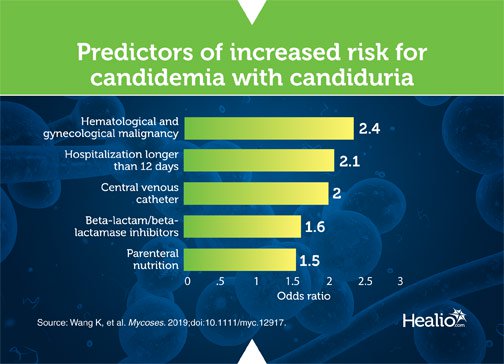Clinical characteristics predict presence of candidemia in patients with candiduria

Researchers identified numerous clinical characteristics that predict the presence of candidemia in patients with candiduria, including receipt of beta-lactam/beta-lactamase inhibitors.
Writing in Mycoses, the researchers explained that candidemia — the most common clinical presentation of invasive candidiasis — is a major cause of morbidity, has an attributable mortality rate of 38% to 49% and is associated with prolonged hospitals stays and high health care costs.
“Candiduria is a predictor for candidemia; however, patient characteristics that are associated with concurrent candidemia in the setting of candiduria are unclear,” Andrej Spec, MD, assistant professor of medicine and associate director of the Infectious Disease Clinical Research Unit at Washington University School of Medicine in St. Louis, and colleagues wrote. “Identifying these characteristics could aid in the early detection of systemic disease.”
Spec and colleagues, including first author Katie Wang, MD, conducted a retrospective cohort analysis using 13 years of data from 4,240 patients with candiduria admitted to Barnes Jewish Hospital in St. Louis between January 2002 and January 2015.

According to the study, 6.2% of the patients had concurrent candidemia. Spec and colleagues found that predictors of increased risk for candidemia with candiduria included hospitalization longer than 12 days (OR = 2.1; 95% CI, 1.7-2.7), presence of a central venous catheter (OR = 2; 95% CI, 1.6-2.6), receipt of parenteral nutrition (OR = 1.5; 95% CI, 1.2-2.0), hematological and gynecological malignancy (OR = 2.4; 95% CI, 1.6-3.5) and receipt of beta-lactam/beta-lactamase inhibitors (OR = 1.6; 95% CI, 1.2-2.2). Elevated heart rate, temperature and creatinine and the presence of neutropenia and neutrophilia also were associated with candidemia.
Factors that demonstrated a decreased risk included diabetes, gastrostomy and presence of a urinary catheter with antibiotic use, Spec and colleagues reported.
“Although Candida species in the urine rarely disseminates into the bloodstream, candiduria has a positive association with candidemia,” they wrote. “To the best of our knowledge, this is the first study to assess potential patient factors that influence the risk of concurrent candidemia with candiduria.” – by Marley Ghizzone
Disclosures: Spec reports receiving research support from Astellas, Scynexis, Cidara, MiraVista and Mayne and consulting fees from Mayne, Scynexis, Astellas, Viamet and Minnetronix. Please see the study for all other authors’ relevant financial disclosures.
